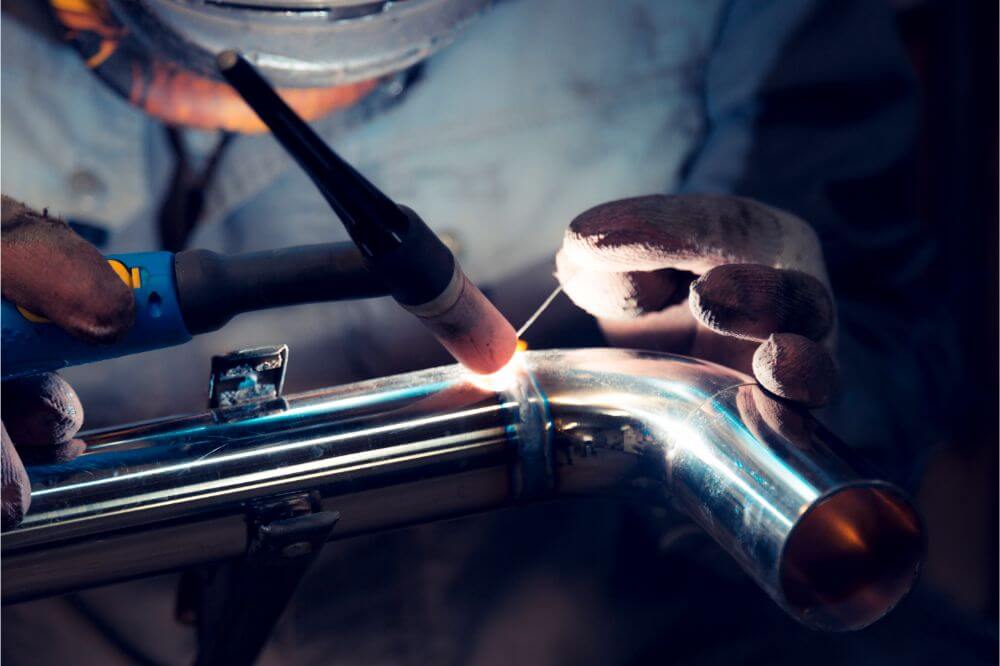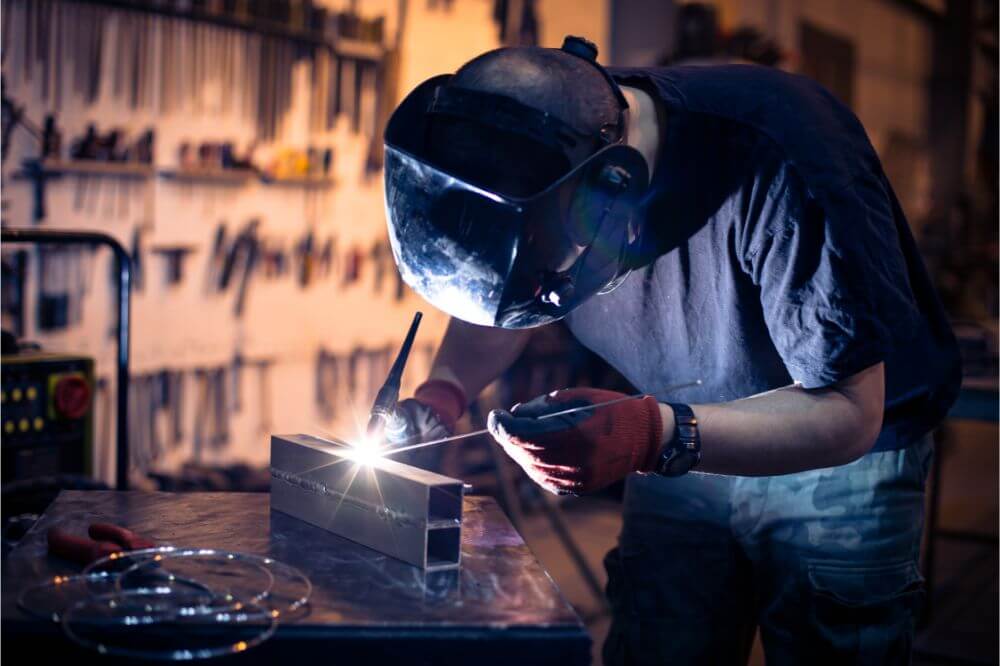Welcome to TIG welding, where precision and skill are vital in joining aluminum parts. This article will explore the benefits and challenges of welding aluminium with tig, along with tips and techniques to help you master this valuable skill.
So, whether you’re an experienced welder or just starting out, keep reading to learn more about welding aluminum with TIG.
- Advantages of TIG Welding Aluminum
- Challenges of TIG Welding Aluminum
- Preparing for TIG Welding Aluminum
- Selecting the Right Welding Equipment
- Choosing an Appropriate Filler Material
- Preparing the Aluminum Surface
- The TIG Welding Process for Aluminum
- Techniques for TIG Welding Aluminum
- Common TIG Welding Aluminum Defects and How to Prevent Them
- Safety Tips for TIG Welding Aluminum
- TIG Welding Aluminum vs. Other Welding Techniques
- Conclusion
Advantages of TIG Welding Aluminum
TIG (Tungsten Inert Gas) welding, also known as GTAW (Gas Tungsten Arc Welding), offers several advantages when joining aluminum parts. The process produces high-quality, clean welds with minimal spatter, making it ideal for intricate and detailed aluminum projects.
Additionally, TIG welding allows precise control over heat input and travel speed, reducing the risk of warping and burn-through. The ability to adjust the AC balance further contributes to TIG welding’s effectiveness on aluminum.
It provides control over penetration, cleaning action, and weld appearance, ultimately resulting in a strong, aesthetically pleasing weld.
Challenges of TIG Welding Aluminum
While TIG welding aluminum offers numerous advantages, it has its challenges. One of the primary issues is the high thermal conductivity of aluminum, which causes heat to disperse quickly.
As a result, it takes more time and energy to establish and maintain a proper weld pool. Welders may also struggle with material contamination, leading to defects like porosity and cracking.
Additionally, aluminum’s softness and oxide layer make it more sensitive to heat input, requiring a skilled hand and proper technique to prevent deformations and blemishes during welding.
Preparing for TIG Welding Aluminum
Before you begin TIG welding aluminum, it’s essential to ensure proper preparation.
First, verify the thickness of the aluminum material you’ll be working with, as this will determine the amperage range needed on your welding machine.
Thicker materials require higher amperage, while thinner materials need lower amperage. Also, note the aluminum alloy used and consider the necessary cleaning techniques, as some alloys may require special attention.
Ensure your welding station has a clean, debris-free workspace and adequate ventilation.
Additionally, wearing the appropriate personal protective equipment (PPE) – such as a welding helmet, gloves, and fire-resistant clothing – is crucial for your safety during welding. When welding aluminum with TIG, adequate preparation is critical to achieving a clean, durable weld.
Selecting the Right Welding Equipment
Choose the right equipment to achieve a quality weld with TIG. You’ll need a TIG welder, which offers more precise control for welding aluminum. It’s also essential to ensure the welder can handle the specific material thickness you’re working with.
A proper tungsten selection is also necessary, as it dramatically affects the welding process. Opt for a tungsten electrode with a 2% lanthanated, ceriated, or zirconiated composition best suited for aluminum welding.
Choosing an Appropriate Filler Material
Choosing the right filler material for welding aluminum with TIG is also essential for the best results. The most common filler metals are 4043 and 5356. While 4043 is more ductile and easier to use, it might not be suitable for some applications due to its lower tensile strength.
On the other hand, 5356 filler metal provides a stronger weld but can be more challenging to work with, especially for beginners. Selecting the proper filler wire will improve weld quality and minimize potential defects.
Preparing the Aluminum Surface
Before you begin welding, properly cleaning the aluminum surface is essential. This will remove any impurities, such as oils, dirt, and oxide layers, that could contaminate the weld and cause defects. Use a clean, stainless steel brush to scrub the material, and clean both the base metal and the filler rod.
Also, avoid using the same brush for multiple materials, which can cause cross-contamination. Additionally, you can use chemical solvents, such as acetone, to help remove contaminants.
The TIG Welding Process for Aluminum
When TIG welding aluminum, ensure the prepared surface is clean and the equipment is set up correctly. Use a proper filler material and selected technique, such as pulsed TIG welding or adjusting the alternating current settings. Remember to use a gas lens for better shielding gas coverage.
Setting Up the Welder
Once you have the necessary equipment and materials, setting up your welder correctly is crucial for quality welds. Begin by ensuring your welder has an appropriately rated torch and electrode. Set the welding amperage according to your workpiece’s thickness and the desired speed.
Don’t forget to adjust the AC balance control to achieve proper penetration and cleaning action. Set the AC frequency to cater to the specific job, considering that higher frequency settings allow for a more focused and stable arc.
Lastly, check that the shielding gas flow rate is appropriate to create a clean and consistent welding process.

Techniques for TIG Welding Aluminum
When welding aluminum with TIG, it’s essential to use proper techniques to ensure a solid and clean weld. Here are some helpful tips to follow. First, maintain a tight arc length to concentrate the heat and provide better penetration.
Angling the torch at around 70 to 80 degrees helps with this. Second, use a push technique, moving the torch toward the weld. This helps maintain a clean weld area by pushing the shielding gas and reducing the chance of contaminants.
Lastly, practice proper filler material addition. Add the filler at the leading edge of the puddle and maintain a steady feeding rhythm.
Pulsed TIG Welding
Pulsed TIG welding is an advanced technique that can significantly improve the quality and appearance of aluminum welds. This process involves pulsing the current at a specific rate, which promotes better control, reduces heat input, and minimizes distortion.
It’s beneficial for thin materials, complex joints, or when welding in difficult positions. To master pulsed TIG welding, experiment with the settings on your equipment and practice consistently to find the best pulse rate and amplitude for your application.
Alternating Current (AC) Settings
When using TIG welding for aluminum, the right alternating current (AC) settings are crucial for achieving a solid and clean weld. With AC, the current alternates between positive and negative, enabling better cleaning action and deeper penetration.
Most modern TIG welders have adjustable AC frequency and balance settings, allowing you to fine-tune the welding process according to the thickness and type of aluminum. Higher frequency settings are ideal for thinner materials, while lower frequencies will provide deeper penetration for thicker materials.
Using a Gas Lens
Using a gas lens in TIG welding aluminum improves gas coverage and helps to reduce turbulence. This results in a cleaner weld and reduces the chances of defects like porosity.
Gas lenses are beneficial when welding on complex surfaces or in tight spaces where gas coverage is essential.
Common TIG Welding Aluminum Defects and How to Prevent Them
Common defects when TIG welding aluminum includes porosity, cracking, and incomplete fusion or penetration. To prevent these issues, ensure proper aluminum surface preparation, use appropriate filler material, and maintain optimal welder settings.
Adjust technique and equipment to avoid such defects for the best results.
Porosity
Porosity, a common issue when welding aluminum, can lead to weak welds. It occurs when hydrogen gas gets trapped in the weld, leading to tiny bubbles or holes.
To prevent porosity, clean the aluminum surface thoroughly, ensure proper shielding gas coverage and settings, and choose the suitable filler material.
Moreover, take your time to allow the gas to properly escape from the weld puddle and perform a pre-weld purge if necessary to remove contaminants that could introduce gases into the weld.
Cracking
Cracking is another common issue faced while welding aluminum with TIG. Ensure proper base material selection, and use matching filler materials to prevent cracking.
Preheating the aluminum can also help in reducing stress and avoid cracking. Additionally, using the proper technique and maintaining a slow, steady travel speed while welding can significantly decrease the chances of cracks forming in your weld.
Incomplete Fusion and Penetration
Incomplete fusion and penetration are two common defects that can occur when TIG welding aluminum. To prevent these issues, ensure proper joint preparation by cleaning the aluminum surface thoroughly and selecting the correct filler material.
Also, proper TIG welding techniques, such as appropriate torch angle and travel speed, can help achieve proper fusion and penetration. It’s also essential to adjust the alternating current settings accordingly to match the thickness of the aluminum workpiece.
Safety Tips for TIG Welding Aluminum
When TIG welding aluminum, it’s essential to prioritize safety. Always wear proper personal protective equipment such as welding gloves, a helmet with a suitable shade, and flame-resistant clothing.
Ensure adequate ventilation in your workspace to avoid inhaling harmful fumes. Keep a fire extinguisher nearby and clear your workspace of flammable materials.
Additionally, inspect your equipment for any damage or malfunction before use to avoid accidents during the welding process. Regularly maintain your equipment to ensure its safety and efficiency.
TIG Welding Aluminum vs. Other Welding Techniques
When comparing TIG welding aluminum to other techniques, TIG offers the best control, precision, and versatility. MIG welding is quicker but has limited control over heat and penetration, leading to potential quality issues.
Stick welding is less common and harder to master for aluminum, as it produces lower-quality welds with more defects.
Overall, TIG welding provides the cleanest, strongest, and most visually appealing welds when working with aluminum, making it the preferred method for most applications.
MIG Welding Aluminum
While TIG welding is highly effective for aluminum, MIG welding can also be an option in certain situations. MIG welding aluminum offers faster travel speeds and is more suitable for longer, continuous welding applications. However, MIG welding might not produce the same aesthetic appeal as TIG.
It’s essential to have the proper equipment and settings for MIG welding aluminum, as this process is susceptible to the material’s thickness and cleanliness.
Stick Welding Aluminum
Stick welding, also known as Shielded Metal Arc Welding (SMAW), is another method for welding aluminum. However, it is considered more challenging and less popular than TIG welding.
The stick welding process requires a higher skill level, and the welds obtained may not be as precise or aesthetically pleasing. Nonetheless, stick welding is a viable option for outdoor applications where shielding gas can be affected by wind or when dealing with thick aluminum plates.
Conclusion
TIG welding is an excellent method for welding aluminum, offering numerous advantages such as enhanced quality, precision, and control.
By following proper preparation, selecting suitable equipment and filler material, and mastering techniques, you can achieve successful, durable aluminum welds with TIG.

